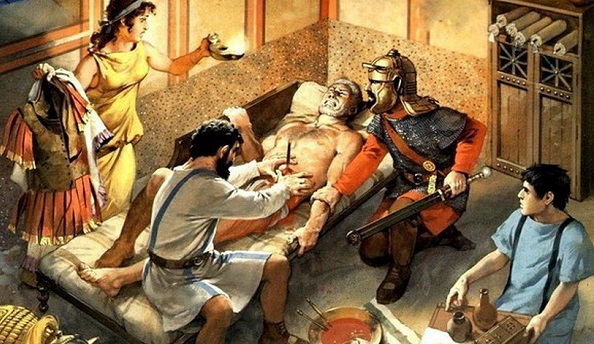Economics of Pharmacy Organization of Pharmacy Activities in Ancient Rome until III-II centuries BC. there were almost no doctors. It was believed that to maintain health, it was enough to visit
Economics of Pharmacy Organization of Pharmacy Activities
In ancient Rome until the III-II centuries. BC. there were almost no doctors. It was believed that to maintain health, it is enough to visit hot baths – term (from the Greek "thermos" – warm).

The first baths, which the population of Rome could use for free, were built in the 3rd century BC. BC. Gradually, they began to include gyms for sports, swimming pools, rooms for medical and hygiene procedures.
Thermae. The benefits of bathing as a preventive and therapeutic tool were already appreciated by the ancient Egyptians. For many peoples of the Ancient East, in India, Persia, Iran, bathing was not only a method of healing, but also part of a religious ritual. In the imperial baths there were magnificent halls for feasts, conversations and meetings, libraries.
The interior halls were decorated with marble statues, among which the place of honor belonged to the images of Asclepius, whom the Romans called Aesculapius, and Hygiene. The cult of the goddess Hygiene came to Rome along with the cult of Aesculapius. Before that, the Romans had their own goddess of health and well-being – Salute.
She was a symbol not only of personal health, but also of general well-being. The name of this goddess has come down to our time in the word "salute", which is used for greeting, as well as in the name of the festive fireworks.
The Romans often used cold water treatment. The first doctors in Rome were immigrants from Greece, mostly slaves, who treated their master and his relatives. Sometimes such slaves were released to free earnings for a certain fee. The freedman doctor gave the former owner part of his income and legally continued to depend on him.
There were special laws to punish bad doctors. Temple medicine, similar to Greek, appeared in Rome during the plague epidemic at the beginning of the 3rd century. BC. Plutarch and Ovid describe in detail how the Romans brought the god Aesculapius in the form of a snake from Epidaurus by ship to Rome. In memory of this event, stones were laid out around the island on the Tiber River, which repeated the outlines of the ship. A temple hospital, similar to the Greek one, was built there.
Cultivation of medicinal plants in ancient Rome
Various diseases were traditionally treated with medicinal plants. It was believed that the best of them grow on the island of Crete, so the Romans often sent herbalists there. In addition, in Rome, as in Greece, medicinal plants were grown in special gardens. The inhabitants of the ancient world appreciated the aromas of medicinal herbs.
It was believed that the smell of mint uplifts the mood, excites the work of thought and contributes to a lively conversation.
Historically existing gardens are known, in which plants were bred for the preparation of poisons. The ruler of Pontus Mithridates Eupator (II-I centuries BC) became famous for this. He constantly took small portions of poisons in order to "accustom" his body to them, because he was afraid of poisoning.
Among the outstanding Roman authors, it is necessary first of all to mention Aulus Cornelius Celsus (1st century BC – 1st century AD) and Dioscorides (1st century). Their writings reflected the diverse medical knowledge of the Romans. Celsus expounded in detail the content of the works of Herophilos and Erasistratus and other doctors of the Alexandrian school, and for centuries his work was perhaps the only serious source of knowledge about the Alexandrian period in the development of medicine, which lasted about 300 years.
Celsus divided medicines into general and special. The general ones were those recommended by Hippocrates in accordance with the humoral theory – cold, hot, dry and wet. Special medicines were those that were selected empirically for the treatment of a specific condition: hemostatic (ice, vinegar), cleansing (ox bile), astringent (alum, borax), cauterizing (pepper, garlic), etc.
Dioscorides' work "On Medicinal Plants" describes more than 600 plants that were then used in medical practice. These descriptions are accompanied by drawings and detailed recommendations for their use. The work of Dioscorides for sixteen centuries was considered in Europe the most authoritative source on medicinal herbs.
The Romans could learn a lot of information about medicinal herbs from the "Natural History" of Pliny the Elder, which is a wonderful example of Roman popular (from the Latin "popidaris" – folk; publicly available; widely known) encyclopedic literature. The works of Galen were famous.
In the works devoted to pharmacology, he wrote that it is not the drugs themselves that have healing power, but some unknown substances that they contain. They are able to pass into the water, but only after the plants are pre-dried.
Collections, infusions, decoctions, extracts, syrups from medicinal herbs are called "Halen preparations". Galen introduced the concept of ballast and active substances in the composition of medicines and began to extract active substances by infusing herbal and mineral preparations with wine, vinegars and oils.
Galen, like the Greek doctors, attached great importance to the prevention of disease. He wrote in detail about the effect of air and food on the body, the importance of sleep, diet and hygiene, as well as movement and peace of mind.
The merit of Galen, who is traditionally considered the founder of experimental physiology, is the creation of a complete system of medical knowledge about the structure and functions of the body.They wrote fundamental works on anatomy and physiology – science on processes occurring in organs and tissues of the body. Galen's books contain complete encyclopedia of medical knowledge of his time.
His anatomical works for fourteen centuries served as guidance for doctors. About 120 genuine writings of Galen preserved, and more than 350 are known by names. Most of them were devoted to medicine.

